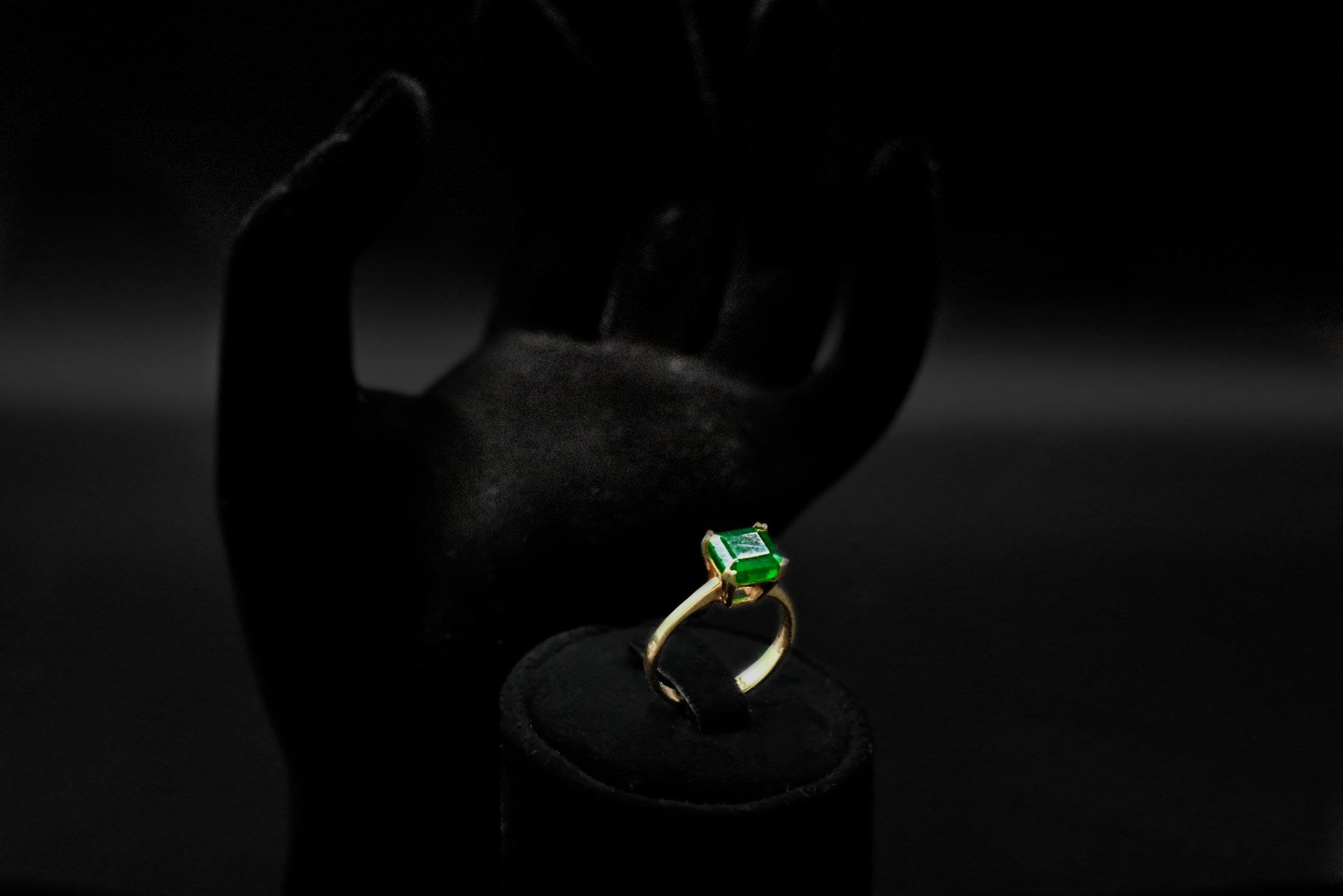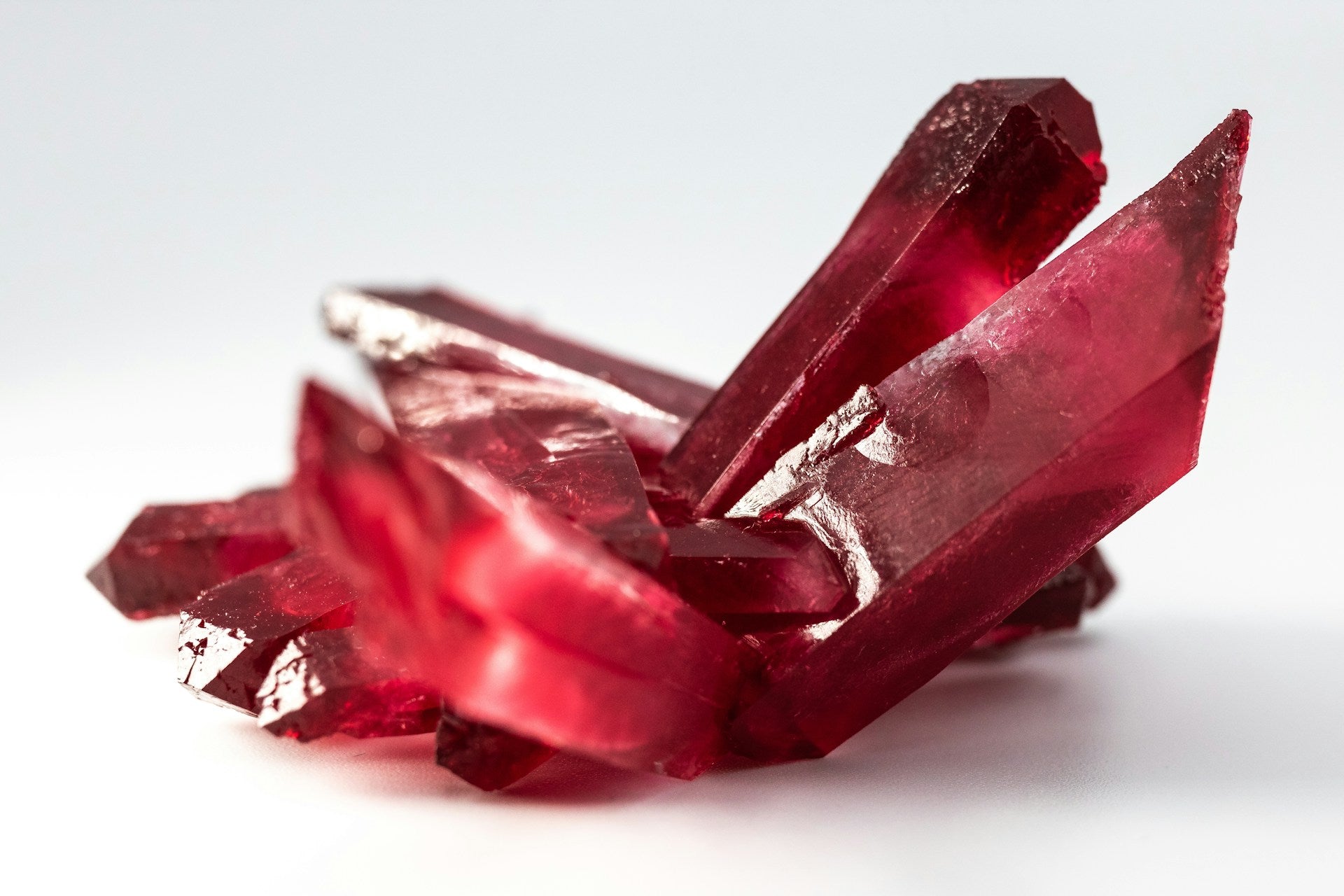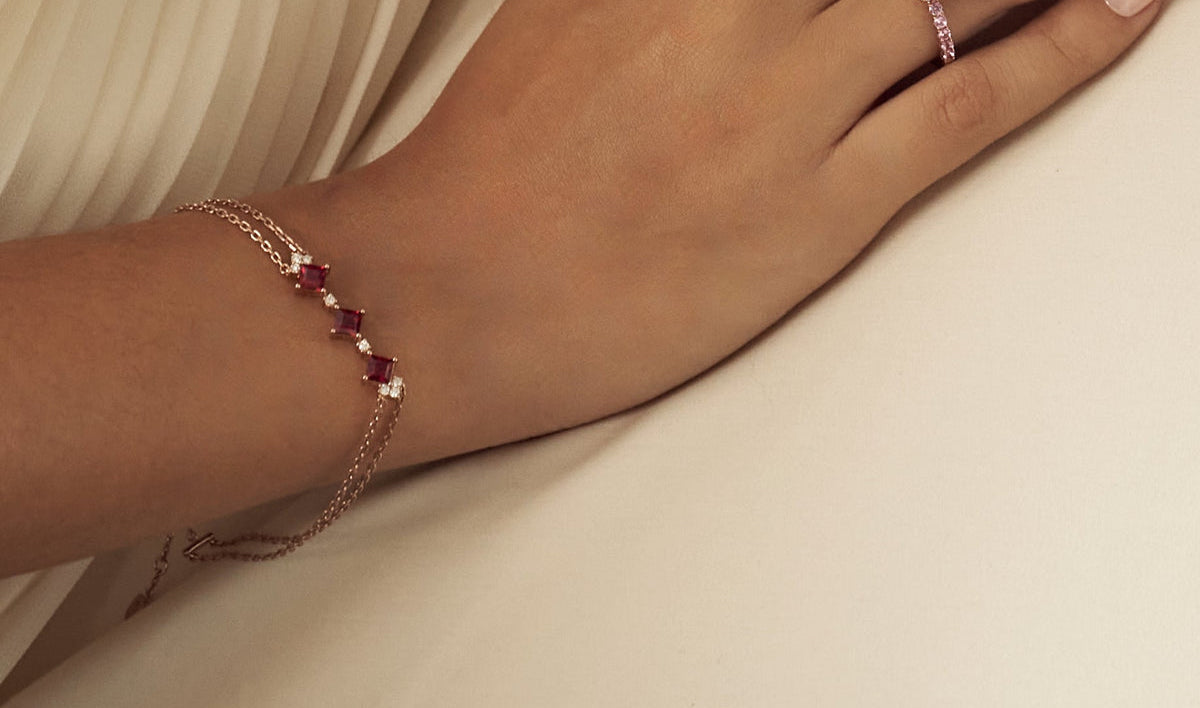
Natural Vs. Lab Grown Emerald: What's the Difference
Table of Content: Inside this Article
...Emerald, a variety of natural beryl, is the traditional birthstone for those born in May. Known for its vibrant green hue, it is often chosen for birthdays or as a meaningful gift like emerald rings for 20th and 35th wedding anniversaries. In this article, we will discuss the comprehensive comparison of natural and lab grown emeralds. So, what exactly makes these stones different?
Emerald: Formation and Chemical Composition
Natural emeralds are formed deep within the Earth's crust under intense heat and pressure. They are composed primarily of beryllium aluminium silicate (BeAl2Si6O18) with trace amounts of chromium, vanadium, and iron, which give them their characteristic green colour. The intensity and hue of the green colour can vary depending on the concentration of these trace elements, ranging from a deep forest green to a light, almost translucent green.
How Are Natural Emeralds Created?
Natural emeralds are created through a complex geological process that takes place deep within the Earth's crust. Over millions of years, rich in beryllium-bearing fluids seep through cracks and fissures in the rock. These fluids react with the surrounding minerals, creating the conditions necessary for the growth of emerald crystals.
The formation of emeralds typically occurs in environments known as pegmatites, which are large, coarse-grained igneous rocks. Pegmatites often contain high concentrations of beryllium, aluminium, and silica, the essential elements for emerald formation.

How Are Lab Grown Emeralds Created?
Lab-grown emeralds, also known as synthetic or cultured emeralds, are created in a controlled laboratory environment using a process called hydrothermal synthesis. This process involves mimicking the natural conditions under which emeralds form in the Earth's crust. Lab-Grown Emeralds can be grown by means of either hydrothermal or flux processes. They are ideal for crafting stunning pieces like emerald necklaces.
Here's a simplified explanation of the hydrothermal synthesis process:
- Raw Materials : The process begins with a mixture of raw materials, including beryllium oxide (BeO) , aluminium oxide (Al₂O₃) , and silica (SiO₂) , which are essential for forming the beryl crystal structure. To achieve the iconic green color of emeralds, chromium oxide (Cr₂O₃) is typically added. In some cases, vanadium may be used as an alternative or additional coloring agent.
- High-Pressure Chamber : The mixture is placed in an autoclave (a high-pressure chamber), which is then heated to temperatures between 600 and 800 degrees Celsius .
- Hydrothermal Conditions : Water is added to the chamber to create hydrothermal conditions , mimicking the natural environment in the Earth's crust where emeralds form. The pressure inside the chamber can reach 700 to 2000 bars .
- Crystal Growth : Over time, the minerals dissolve in the hot water solution and recrystallize, forming emerald crystals. The growth rate and crystal quality can be controlled by adjusting the temperature, pressure, and chemical composition of the solution.
Flux Process
This method uses a molten flux, a substance that lowers the melting point of the raw materials. The materials are dissolved in the flux and heated until emerald crystals form as the mixture cools. Afterward, the crystals are separated from the flux, often using acids to remove any residue.
The resulting lab-grown emeralds are chemically and physically identical to natural emeralds. They are indistinguishable to the naked eye. Specialised tools can reveal subtle differences, such as unique inclusions from the growth process.
Advantages of Lab-Grown Emeralds
- Ethical Considerations : Lab-grown emeralds are considered a more ethical choice since their production avoids labor exploitation and unsafe conditions often associated with gemstone mining. They also bypass the human and environmental costs of mining. While some natural emeralds come from certified ethical sources, ensuring fair practices and community protection in mining regions remains a challenge.
- Lower Cost : Lab-grown emeralds are generally less expensive than natural emeralds of similar quality, offering consumers a more affordable option without compromising on size, color, or clarity.
- Consistent Quality : Lab-grown emeralds offer more consistency in color, clarity, and size compared to natural emeralds, which often vary due to inclusions and other natural imperfections, making them perfect for matching pieces such as emerald earrings.
- Customisation : The process of creating lab-grown emeralds allows for greater flexibility in terms of color, size, and shape, making it easier to meet specific design requirements.
- Sustainability : Mining is inherently unsustainable, relying on finite resources and often causing ecological harm, such as habitat destruction and pollution. Lab-grown emeralds have a much lower environmental impact since they don't require excavation or resource depletion. However, their sustainability depends on the energy used—if renewable sources are employed, they become even more eco-friendly.
Limitations of Lab-Grown Emeralds
- Perceived Value : Lab-grown emeralds are often seen as less valuable than natural ones due to their synthetic origin, which affects resale value. While chemically and physically identical to natural stones, collectors and investors prefer natural gems for their rarity.
- Market Value: Lab-grown emeralds may not appreciate in valulike natural emeralds over time.
- Limited Availability of Large Stones : While lab-grown emeralds can be customised in size, growing consistently large stones remains challenging. This limits options for those seeking very large emeralds.
- Energy Use in Production : Lab-grown emeralds have a lower environmental impact than mining, but their production consumes significant energy, if not sourced from renewables.
| Aspect | Lab-Grown Emeralds | Natural Emeralds |
|---|---|---|
| Cost | ✅ More affordable: $150-$1,000 per carat for high quality | ❌ More expensive: $1,000-$100,000+ per carat for high quality |
| Availability | ✅ Widely available in various sizes | ❌ Rarer, especially in large, high-quality stones |
| Colour Consistency | ✅ Highly consistent colour | ❌ Colour can vary, even within the same stone |
| Clarity | ✅ Often higher clarity, fewer inclusions | ❌ Usually more inclusions, which can affect clarity |
| Size Availability | ✅ Available in larger sizes | ❌ Large, high-quality stones are extremely rare |
| Environmental Impact | ✅ Lower: No mining required | ❌ Higher: Mining can have significant environmental effects |
| Ethical Concerns | ✅ Minimal ethical issues | ❌ Potential issues with mining practices and fair labour |
| Investment Value | ❌ May not appreciate in value | ✅ Can appreciate over time, especially high-quality stones |
| Rarity | ❌ Not rare | ✅ Truly rare, especially fine specimens |
| Historical Significance | ❌ Lack historical allure | ✅ Rich in history and cultural significance |
| Production Time | ✅ Weeks to months | ❌ Millions of years |
| Durability | ✅ 7.5-8 on Mohs scale | ✅ 7.5-8 on Mohs scale |
| Chemical Composition | ✅ Identical to natural emeralds | ✅ Be3Al2Si6O18 with chromium and vanadium |
| Refractive Index | ✅ 1.565-1.602 | ✅ 1.565-1.602 |
| Heat Conductivity | ✅ Low | ✅ Low |
| Fluorescence | ❌ Usually no fluorescence | ✅ Often none, but can fluoresce red under UV in rare cases |
Identifying Natural vs. Lab-Grown Emeralds: A Closer Look
While natural and lab-grown emeralds share many physical similarities, not identifiable with naked eyes. there are subtle differences that can be detected through specialised testing. Gemologists use a combination of techniques, including microscopic examination, spectroscopy, and fluorescence testing, to determine the origin of an emerald.
For instance, microscopic examination can reveal the presence of inclusions, which are small imperfections or internal features that are often unique to natural emeralds. Spectroscopy can analyse thow the emerald absorbs and emits light, providing information about its chemical composition and trace elements. Fluorescence testing examines the stone's reaction to ultraviolet (UV) light, with synthetic stones sometimes showing a stronger or more uniform response under UV light.
Let’s take a look at the comparison of natural and lab created emeralds in the table below.
| Property | Natural Emeralds | Lab-Grown Emeralds |
|---|---|---|
| Colour | Varies (green, bluish-green, yellowish-green). Often treated, with oiling commonly used to enhance colour and clarity. | Consistent in color and quality, offering various shades without treatments. |
| Clarity | Often contain inclusions | Typically have fewer to no inclusions, may appear clearer |
| Hardness | 7.5 on the Mohs scale | 7.5 on the Mohs scale |
| Specific Gravity | 2.67-2.70 | 2.67-2.70 |
| Fluorescence | Can exhibit red or orange fluorescence under UV light | Can exhibit red or orange fluorescence under UV light |
While both natural and lab-grown emeralds are beautiful and valuable gemstones, understanding their key differences is essential for making informed purchasing decisions. By carefully considering the physical properties, ethical implications, and personal preferences, consumers can choose the emerald that best suits their individual needs and values.
Pricing and Market Value of Natural and Synthetic Emeralds
The price of an emerald, whether natural or lab-grown, is determined by several factors, including its colour, clarity, cut, and carat weight (the Four Cs).
Colour
- Natural Emeralds: The most valuable natural emeralds are those with a deep, rich green colour. Emerald hues ranging from bluish-green to yellowish-green are generally less valuable.
- Lab-Grown Emeralds: Lab-grown emeralds can be produced in a variety of colors, but the most desirable shades are those that closely resemble natural emeralds.
Clarity
- Natural Emeralds: Natural emeralds often contain inclusions, which can affect their clarity and value. However, certain types of inclusions, such as "garden-like" inclusions, can enhance the character and value of a natural emerald.
- Lab-Grown Emeralds: Lab-grown emeralds typically have fewer inclusions and may appear clearer than natural emeralds. However, modern techniques allow for the creation of lab-grown emeralds with intentional inclusions to mimic the appearance of natural emeralds.
Cut
- Natural and Lab-Grown Emeralds: The cut of an emerald can significantly influence its appearance and value. A well-cut emerald will maximize its brilliance and minimize its imperfections, which is essential when crafting exquisite pieces like emerald bracelets.
Carat Weight
- Natural and Lab-Grown Emeralds: Larger emeralds are generally more valuable than smaller ones, but the overall quality (colour, clarity, and cut) is more important than the carat weight.
Market Value
- While lab-grown emeralds are gaining acceptance, they are unlikely to appreciate significantly in value over time because their production can be continued, unlike natural gems.
In addition to the Four Cs, other factors that can affect the market value of emeralds include:
- Origin: Emeralds from certain countries, such as Colombia, are often perceived to be more desirable and may command higher prices.
- Certification: A gemstone certificate from a reputable laboratory can provide assurance of the emerald's quality and authenticity. At Juvetti, all emerald jewelleries come with proper certification from GIA (Gemological Institute of America) .
It is important to note that the emerald market is dynamic and subject to fluctuations. Factors such as economic conditions, consumer trends, and technological advancements can all impact the pricing and market value of emeralds.

Natural or Lab Grown Emerald Questions
What is the difference between natural and lab-grown emeralds?- Natural emeralds form over millions of years deep within the Earth's crust, while lab-grown emeralds are created in a controlled laboratory environment that simulates the natural formation process. Both types of emeralds share the same chemical composition and crystal structure, but they may differ in physical properties such as inclusions.
- Identifying the origin of an emerald often requires specialised testing by a gemologist. Factors such as inclusions, fluorescence, and spectroscopic analysis can provide clues about whether an emerald is natural or lab-grown.
- Historically, natural emeralds have commanded higher market values than lab-grown emeralds due to their rarity and geological formation. While lab-grown emeralds have become more accepted by consumers in recent years, the price gap between natural and lab-grown emeralds remains
- Many consumers consider lab-grown emeralds more ethically sourced than natural emeralds, as their production does not involve the exploitation of miners or the destruction of natural habitats. However, some critics argue that the production of lab-grown emeralds may contribute to the devaluation of natural emeralds, which could have negative consequences for the mining industry.
-
Clean regularly: Wipe with a soft microfiber cloth for daily maintenance. For deeper cleaning, use warm soapy water and a soft-bristled brush, then rinse thoroughly. Pat dry with a soft, lint-free cloth and allow the jewelry to air-dry completely.
-
Avoid harsh chemicals: Avoid using harsh chemicals, such as chlorine, ammonia, or ultrasonic cleaners, as they can damage the emerald.
-
Store properly: Store your emerald jewellery in a soft pouch or a jewellery box to protect it from scratches and other damage.
-
Have it inspected regularly: Have your emerald jewellery inspected by a professional jeweller every year to ensure its setting is secure and the emerald is in good condition.
- Emeralds are generally colorfast and do not fade over time under normal conditions. However, prolonged exposure to harsh chemicals, extreme heat, or excessive sunlight can damage the stone or its surface, potentially affecting its appearance. To protect your emerald jewellery, handle it with care and avoid exposing it to these conditions.





